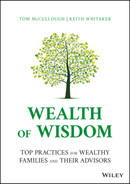Foreword
James E. Hughes, Jr.
“On Entering the Room”
When Tom and Keith invited me to contribute to this new book, they posed to me (and to the other wonderful contributors) a challenging question: What is the one practice that you have found most powerful in helping families?
Through reflecting on this question, I could not decide on just one practice, and so I offered two, the Family Bank and Grandchild-Grandparent Philanthropy. The editors generously included both chapters in the pages that follow.
But in approaching this completed volume, and thinking about you, the reader, one more practice came to my mind, which I want to share with you here, as you embark on this learning journey.
Many years ago, I found myself outside a conference-room in a large resort. I was about to enter a room where 25 or 30 family members of a family I'd gotten to know fairly well had gathered.
They had asked me to come and talk with them. As I approached the room, I was full of the “curriculum” that the family leaders and I had spent weeks assembling. We had really worked hard to prepare for this meeting.
But suddenly I found myself standing outside the door and experiencing a feeling I had had sometimes in the theater. I thought, “I have to stop for a minute here.” And so, I found a quiet place, and I thought, “Well, if I'm five minutes late, I'm sure it will be alright.”
I sat down, and in that moment, I received a gift. The gift was that I began to think, somewhat randomly at first and then much more conscientiously, about each person whom I was about to touch. As I thought about each person, the question came to me, “How can I help?”
I began to find myself smiling about each of those people. I began to think, “Gosh, she's 35. I imagine her questions might be so-and-so. And then, oh my, he's about 70. He's at different stage of life than she is. I wonder what his questions are?” As I went through those 25 or so people rather quickly, each of them came into my consciousness. I could see each one of them, at the stage of life he or she was in. I could imagine what kinds of questions each of them might have. And I began to feel calm.
Then I began to think of them as a community. What stage of life was their community at? What were the likely questions of that community, at that stage of life?
I began to smile. I thought, “I know why I'm doing this. I knew that the curriculum would be okay. And the materials will be okay. But really my task is to gently help the good ideas in the curriculums move into connection with, into awareness of, the lives of each of those people, at each of their stages of life, and in response to the questions of that person, in that stage of life.
I have now done this same exercise hundreds of times. I do not enter a room without thinking about each of the people inside. I think about the kinds of questions each person will have, the questions proper to his or her stage of life.
By the way, one of the things that happens when you enter the room this way is that you leave your expertise at the door. It just vanishes. You go into that room with a beginner's mind, no matter how well you prepare, no matter how much material there is. You greet your colleagues with a hug, and you greet the family with a hug. Because you've met them already.
Now one more thing: Turn this exercise upon yourself. You are the person in the room of your life. These many contributors, these many chapters, wait outside the door, ready to greet you. Who are you? What stage of life are you in? What are the questions you face? How about the people dearest to you—where are they in their lives and what are their questions? Take a few minutes to sit and think through these questions. Then give yourself a hug and open the door.
